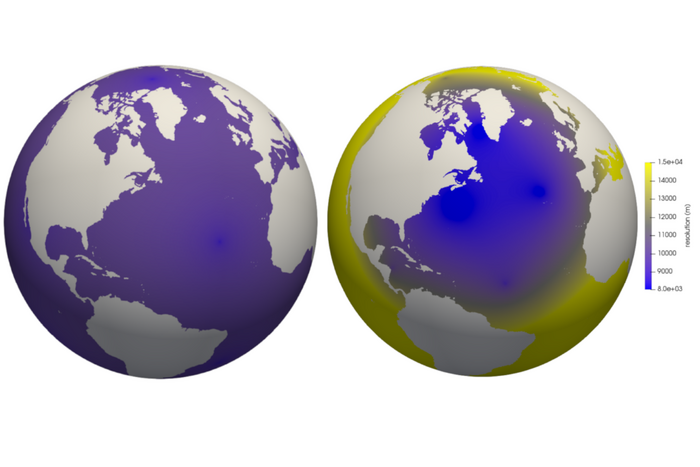One more ICON milestone reached
In the paper “ICON-O: The Ocean Component of the ICON Earth System Model—Global Simulation Characteristics and Local Telescoping Capability” that appeared in the Journal of Advances in Modelling Earth Systems, the authors show first that ICON-O in an eddy-rich simulation with uniform horizontal resolution of nominally 10 km represents the circulation well in comparison with observations and with other ocean models of similar resolution. This is noteworthy since it demonstrates that models on uniform grids such as ICONs icosahedral grid are able to capture the non-uniform ocean circulation.

The authors then proceeded by creating a computational telescope of locally higher resolution in the North Atlantic. This is accomplished by shifting the grid nodes of a uniform and coarser grid towards a focal region in the North Atlantic. The resulting resolution in this focal area was chosen similar as in the eddy-rich experiment at uniform resolution. It turned out that in the North Atlantic the simulated circulation in the focal area remains over a decadal time scale close to the circulation of the highly resolved uniform configuration. This result proves that local zooming is a viable experimental option and demonstrates ICON-O’s telescoping capability. This line of research is continued in Sapphire’s “Submesoscale Telescope Experiment” (Hohenegger et al., 2022).
A similar but different type of telescoping, in which degrees of freedom were added locally to the grid to implement a coastal refinement, was the subject of the paper “Seamless Integration of the Coastal Ocean in Global Marine Carbon Cycle Modeling” by Mathis et al (2022), which included marine biogeochemistry in form of HAMOCC. This paper was an “Editor’s Highlight” at EOS.
In summary, ICON-O is able to simulate eddy dynamics in its uniform configuration and it also keeps the promise of unstructured grid models to allow great flexibility under grid refinement. The possible zooming into arbitrary regions of interests via the telescoping configuration opens new research possibilities.
References
Korn, P., Brüggemann, N., Jungclaus, J., Lorenz, S., Gutjahr, O., Haak, H., Linardakis, L., Mehlmann, U., Mikolajewicz, U., Notz, D., Putrasahan, D., Singh, V., von Storch, J.-S., Zhu, X, Marotzke, J. (2022) ICON-O: The Ocean Component of the ICON Earth System Model—Global Simulation Characteristics and Local Telescoping Capability”. Journal of Advances in Modeling Earth Systems, 14(10). doi.org/10.1029/2021MS002952.
Hohenegger, C. et al. (2022) ICON-Sapphire: simulating the components of the Earth system and their interactions at kilometer and subkilometer scales. Submitted, Geoscientific Model Development.doi.org/10.5194/gmd-2022-171.
Mathis, M., Logemann, K., Maerz, J., Lacroix, F., Hagemann, S., Chegini, F., Ramme, L., Ilyina, T., Korn, P., Schrum, C. (2022) Seamless integration of the coastal ocean in global marine carbon cycle modeling. Journal of Advances in Modeling Earth Systems, 14(8). doi.org/10.1029/2021MS002789.
Contact:
Dr. Peter Korn
Max Planck Institute for Meteorology
Email: peter.korn@mpimet.mpg.de
